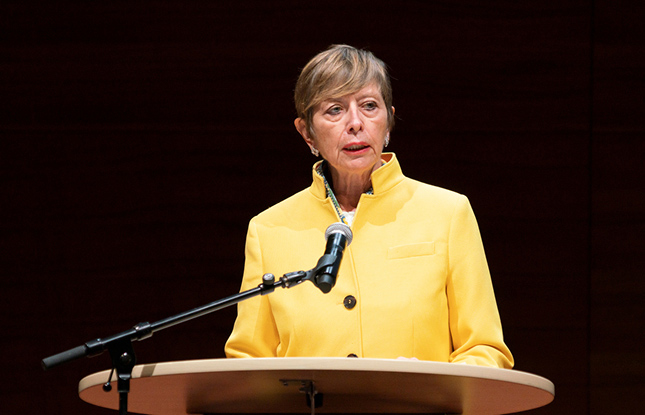Simone Beck is the president of the Luxembourg Commission for Cooperation with UNESCO. For half a year now Minett UNESCO Biosphere has been member in UNESCO’s global network “Man and the Biosphere”, a good moment to ask three questions to Simone Beck.

What role does a world organisation, like UNESCO, play in the preservation of history, culture and the conservation of nature and biodiversity in the different member states of the organisation, especially in Luxembourg?
The concept of UNESCO was developed during the Second World War by the exiled European governmental Ministers of Education in the British capital, London. Founded in October 1945, UNESCO’s mission is to spread peace and human rights through improved education of tolerance and mutual understanding, through natural, social and human sciences, and through culture (whose essential foundation is the creativity and talent of all human beings). Thus, it created the World Heritage programme, which brings together cultural and natural sites of exceptional universal value, such as the old quarters and fortifications of the City of Luxembourg, which were accepted in this prestigious programme in 1994. The documentary heritage of mankind, better known as “The Memory of the World”, is a fascinating programme, as it shows us through music scores, medieval manuscripts, war archives, slave registers or technical sketches what inventiveness human beings are capable of. For better or for worse. Since 2003, the photographic exhibition “The Family of Man” at the Château de Clervaux, designed by Edward Steichen, has been part of “Memory of the World”. But the creativity of human beings does not only show itself in tangible things: the domain of intangible heritage is immense. Customs, rituals, dances, gastronomy, maieutics, coffee ceremonies or earthen wine making, are all examples of a living heritage. Luxembourg is represented twice on the Register of Intangible Heritage of Humanity: since 2010 with the dancing procession of Echternach and since 2020 with the musical art of blowing the Haupesch-Bléiser horn.
Through its “Man and the Biosphere” programmes, the “Global UNESCO Geoparks” or its numerous initiatives in the protection of aquatic realms or its research in the context of climate change, UNESCO is fighting on many fronts to help achieve the Sustainable Development Goals of the 2030 Agenda. In Luxembourg, the designation of the 11 communes of the Pro-Sud as a “Minett UNESCO Biosphere” makes them all model regions for sustainable development. A great honour and a great challenge. It is indeed a question of reconciling economic and urban development with respect for the environment and natural resources.
The Minett UNESCO Biosphere is part of the Man and the Biosphere programme, which celebrates its 50th anniversary this year. What are the benefits to nature, the economy, and the inhabitants of the southern region of Luxembourg of including Minett in this network?
The benefits are manifold. Being a biosphere contributes to a better social cohesion of the region and an increased interest in its ecological potential and its natural and cultural wealth. Furthermore, there is great potential for collaboration between the economic sector and ecological initiatives. UNESCO does not want to impose rules on industrial or artisanal firms in the region: it hopes that having their headquarters in a biosphere contributes to a greater awareness of sustainability and resilience.
In your opinion, what are currently the major challenges for UNESCO sites and heritage, both in Luxembourg and elsewhere in the world?
Humanity is facing major challenges: climate change, water and sea pollution, the disappearance of insects, the poor state of forests, the irresponsible behaviour of consumer societies, intensive agriculture, and ever-increasing urbanisation caused by the population explosion. Climate change, already responsible for the rise in sea levels and the melting of the polar ice caps, will lead to the disappearance of Pacific archipelagos, animal and plant species, and will force thousands of people to leave their flooded, or too arid, or simply disappeared homes. Climate refugees will be added to the huge number of people who leave their countries because of war or persecution. Erosion and climate change are already affecting many UNESCO sites, which have been listed as being in danger.
A major challenge consists in changing our mentalities: eating strawberries at Christmas, organic potatoes imported from Chile, flying for short distances, drinking water (preferably from the Himalayas) in plastic bottles, buying a 5-euro T-shirt made in atrocious conditions on the other side of the world, buying meat so cheap that it can only come from mass farming, changing our smart-phone every year…: the list of challenges is huge. But it is up to all of us to save this planet. We have no other.
We hope that the Minett UNESCO Biosphere will encourage the inhabitants, NGOs, entrepreneurs, and scientists based there to develop new initiatives, proposing truly sustainable approaches and alternatives to the current way of operating. It is therefore also a region oriented towards renewal, remixing and reinvention, with a view to development that is more respectful of the mutually enriching relationship between man and nature or man and planet.



